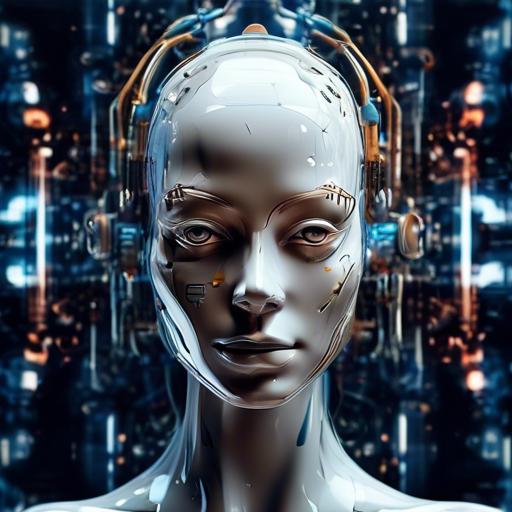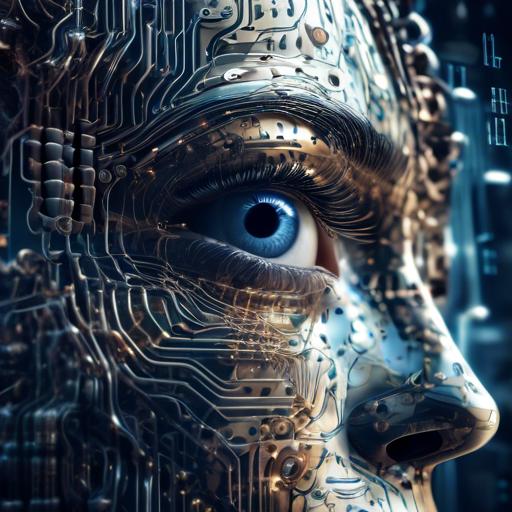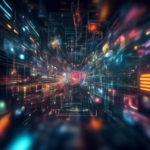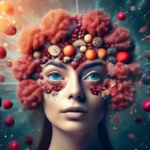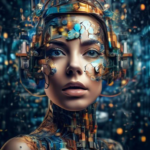Picture this: a world where imagination fuels creation, where the stroke of a digital pen can conjure scenes straight out of dreams, and where art transcends the boundaries of conventional tools. Welcome to the fascinating realm of AI image generation! In this extraordinary landscape, algorithms become the muse, pixels burst into life, and the marriage of technology and artistry gives birth to wondrous masterpieces. Whether you’re an artist curious about the potential of AI, an enthusiast eager to dive into the creative synergy between human and machine, or simply someone looking to understand this revolutionary step in visual expression, you’ve arrived at the right place. Let’s embark on a journey to uncover the basic concepts of AI image generation, demystifying the tech and unlocking the endless possibilities it offers. With open minds and inspired hearts, we’ll explore how artificial intelligence is reshaping the canvas, one pixel at a time.
Table of Contents
- Understanding the Core Principles of AI Image Generation
- Unveiling Algorithms: The Magic Behind AI Image Creation
- Training Data: The Backbone of AI Artistry
- Neural Networks: Mimicking the Human Brain for Visual Creativity
- Generative Adversarial Networks: The Dynamic Duo of AI Innovation
- Fine-Tuning Models to Enhance Image Quality
- Overcoming Ethical Challenges in AI Image Generation
- Practical Applications and Real-World Success Stories
- Future Trends and Emerging Technologies in AI Artistry
- To Conclude
Understanding the Core Principles of AI Image Generation
At the heart of AI image generation is a blend of sophisticated technologies and intuitive algorithms. Understanding these core principles is essential for grasping how machines can create realistic images from scratch. These principles form the backbone of various AI-driven creative tools, giving birth to stunning visuals and providing support to a myriad of industries.
**Generative Adversarial Networks (GANs)** are a primary driving force behind AI image creation. GANs consist of two neural networks, the generator and the discriminator, working in tandem. The generator creates images from random noise, while the discriminator evaluates these images’ authenticity. **Through an iterative process, the generator improves its output, yielding more lifelike and accurate images over time.**
Another vital component is **deep learning**. By leveraging vast datasets and multiple layers of neural networks, AI can learn intricate patterns and nuances of visual data. This deep learning process allows AI to mimic various styles, textures, and details observed in real-world images. It is also instrumental in applications such as image restoration, colorization, and style transfer.
Here are the essential steps AI follows in image generation:
- **Data Acquisition:** Collecting massive datasets containing images that serve as the learning base.
- **Preprocessing:** Cleaning and organizing the data, ensuring that it is suitable for training.
- **Model Training:** Using machine learning algorithms to teach the AI to recognize patterns and generate images.
- **Generation and Refinement:** Creating images and refining them through feedback loops to improve quality.
**Autoencoders** also play a role, operating by compressing images into a latent space and decompressing them back to their original form, or enhanced versions thereof. This technique is often used in image denoising and other enhancement processes. By learning efficient codings, autoencoders are pivotal in reducing noise and improving quality in generated images.
Unveiling Algorithms: The Magic Behind AI Image Creation
Imagine a world where computers can mimic the creative instincts of renowned artists to craft breathtaking visuals effortlessly. At the heart of this wizardry are algorithms designed to understand and replicate intricate patterns seen in various forms of art. These algorithms, often driven by **Machine Learning** and **Neural Networks**, allow machines to generate, manipulate, and enhance images in ways that seem almost magical.
**Types of Algorithms:**
- Generative Adversarial Networks (GANs): These involve two neural networks, the generator and the discriminator, playing a game of cat and mouse to improve each other’s performance. The result? Astoundingly realistic images.
- Convolutional Neural Networks (CNNs): They excel in identifying patterns and structures within images. While originally designed for image recognition, CNNs have found incredible applications in generating new visuals.
The blend of these powerful networks offers the core mechanics behind AI image creation. GANs, for instance, utilize the generator to produce images and the discriminator to evaluate them. Over time, this ongoing battle between creation and evaluation fine-tunes the system’s ability to craft visuals that are almost indistinguishable from those made by human hands.
Let’s look at an example of how GANs work:
| Step | Generator | Discriminator |
|---|---|---|
| 1 | Generates a new image. | Evaluates the image’s realism. |
| 2 | Receives feedback on the image. | Learns to better distinguish real from fake. |
| 3 | Refines the generation process. | Continuously improves. |
**Key Benefits** of AI Image Generation:
- Time Efficiency: Images that might take a human artist hours or days can be generated in minutes.
- Resource Optimization: Reduces the need for extensive material resources in the creative process.
- Endless Possibilities: Allows for the creation of visuals that might be impossible to achieve manually.
By exploring these foundational algorithms, we unlock the potential for innovation in art, design, and beyond. The magic of AI is not just in the images it creates, but in how it expands the boundaries of human creativity, opening new doors for artists and technologists alike.
Training Data: The Backbone of AI Artistry
At the core of **AI image generation** lies the invaluable asset known as training data. This data serves as the raw material, shaping the creative capabilities of algorithms and enabling them to produce awe-inspiring pieces of digital art. But what exactly makes training data so pivotal? It’s the rich, diverse troves of images fed into the AI systems that allow these digital artists to learn the subtleties of aesthetics, form, and style.
Consider training data as the pigments to the AI’s brush. Without a broad spectrum of hues, the resulting artwork would lack vibrancy and depth. For an AI model to generate realistic or stylistically accurate images, it must have been exposed to a huge variety of reference pictures. The more diverse and high-quality the dataset, the more nuanced and sophisticated the artwork becomes.
- Diversity: Encompasses a wide range of styles, subjects, and conditions.
- Quality: High-resolution, well-annotated images are crucial.
- Volume: Thousands to millions of images are often necessary.
Table: Key Qualities of Ideal Training Data
| Quality | Description |
|---|---|
| Diversity | Varied styles, subjects |
| Quality | High-resolution, annotated |
| Volume | Thousands of images |
Data augmentation techniques act as a magnifying glass, expanding the utility of existing datasets without the need for additional costly data collection. Simple manipulations such as rotation, flipping, and color adjustments can exponentially enhance the dataset’s effective size, offering the AI more varied examples to learn from. Such practices make sure that the model isn’t just memorizing data, but genuinely understanding and internalizing artistic concepts.
In essence, training data is the canvas upon which AI hones its artistry. Thoughtfully curated and augmented datasets imbue AI with the ability to not just replicate, but innovate, taking inspiration from real-world sources to craft new, captivating visuals. As we continue to refine these datasets, we empower AI to push the boundaries of creativity ever further.
Neural Networks: Mimicking the Human Brain for Visual Creativity
Imagine connecting the dots between neurons to form patterns, almost like a real-life jigsaw puzzle for the brain. This is precisely what neural networks do, but instead of physical neurons, they use algorithms. These algorithms, enriched by data and training, are capable of remarkable feats like generating images that mimic human creativity.
At the core of these networks are layers. Think of them as artists working together in harmony. We have the input layer, which takes in raw data such as pixels of an image, and the output layer, which produces the final picture. In between lie hidden layers, analogous to the brain’s neurons making complex decisions. The hidden layers apply various transformations to the data received, enhancing it step-by-step, until an astonishingly creative image is produced.
One key element in this intricate process is the **activation function**. It’s comparable to the spark that fires neurons. Common activation functions include:
- ReLU (Rectified Linear Unit): Used to introduce non-linearity into the model, helping to capture complex patterns.
- Sigmoid: Squashes values between 0 and 1, particularly useful in binary classifications.
- tanh (Hyperbolic Tangent): Similar to sigmoid but ranges between -1 and 1, making it useful for zero-centering data.
Tables illustrate how these activation functions differ:
| Activation Function | Range | Best Used For |
|---|---|---|
| ReLU | 0 to ∞ | General hidden layers |
| Sigmoid | 0 to 1 | Binary Classification |
| tanh | -1 to 1 | Zero-centered data |
Perhaps the most fascinating application of these neural networks is in Generative Adversarial Networks (GANs). GANs consist of two sub-networks: the Generator and the Discriminator. It’s a bit of a cat-and-mouse game where the Generator tries to produce realistic images, and the Discriminator attempts to distinguish between real and fake images. Over time, this tussle leads to incredibly photo-realistic imagery, enough to baffle the human eye.
As these networks evolve, they not only aid artists in creating new masterpieces but also open up avenues in various other fields. For instance:
- Medical Imaging: Assisting radiologists in detecting anomalies.
- Fashion Design: Creating new patterns and styles.
- Architecture: Generating futuristic building designs.
The implications of neural networks for visual creativity are profound and ever-expanding. With each passing day, these artificial ‘brains’ get closer to mimicking the boundless imagination inherent in human creativity, making the impossible, possible.
Generative Adversarial Networks: The Dynamic Duo of AI Innovation
In the exciting world of AI, Generative Adversarial Networks (GANs) stand out as a groundbreaking innovation that has reshaped how machines understand and generate images. At their core, GANs are built on the principle of *adversarial learning*, where two neural networks—the Generator and the Discriminator—pit against each other in a metaphorical game of cat and mouse.
The **Generator** starts its task by creating images from random noise, with the aim of producing outputs that are indistinguishable from real images. On the other side, the **Discriminator** acts as the gatekeeper, evaluating each image to determine whether it is genuine or a product of the Generator’s imagination. This antagonistic interplay continues until the Generator becomes incredibly proficient at crafting images that can deceive even the sharpest Discriminator.
Some key benefits of this innovative duo include:
- Realism: GANs can produce images that are strikingly realistic, making them valuable in industries ranging from entertainment to fashion.
- Creative Potential: By tapping into the creative capabilities of GANs, artists and designers can explore new realms of creative expression.
- AUTOMATION: GANs can automate the creation of content, saving significant time and resources for content creators.
Despite their power, training GANs can present challenges. Here are a few common obstacles:
- Instability: The training process can be volatile, often leading to inconsistent results.
- Mode Collapse: The Generator might converge to only a few types of outputs, reducing the diversity of generated images.
- Resource Intensive: GANs require substantial computational power and time to train effectively.
| Term | Definition |
|---|---|
| Generator | Neural network that creates images from random inputs. |
| Discriminator | Neural network that evaluates the authenticity of images. |
| Adversarial Learning | Training methodology where two models compete to improve each other. |
As GANs continue to evolve, they hold the promise of uncharted advancements. From creating hyper-realistic virtual worlds to enhancing scientific research with synthetic data, the potential applications are limitless. The dynamic synergy between the Generator and the Discriminator not only pushes the boundaries of what’s possible but also continues to redefine the future of AI innovation.
Fine-Tuning Models to Enhance Image Quality
In the realm of AI-driven imagery, fine-tuning models is akin to the final brushstrokes of a master painter, bringing intricacy and depth to digital creations. This process involves adjusting pre-trained neural networks, leveraging transfer learning to enhance the precision and detail of image outputs. The core aim is to refine the model for specific tasks, such as noise reduction, color enhancement, and high-resolution synthesis.
- Noise Reduction: Fine-tuning helps to eliminate unwanted distortions and artifacts, ensuring that images appear clean and smooth.
- Color Enhancement: By adjusting the model’s parameters, one can achieve more vivid and accurate color representations.
- High-Resolution Synthesis: Fine-tuning enables the generation of images with higher clarity and finer details.
The journey of fine-tuning typically starts with selecting a pre-trained model that has been trained on a large and diverse dataset. This model serves as the foundation. For instance, models like GANs (Generative Adversarial Networks) or VAEs (Variational Autoencoders) are often used because of their robustness in generating high-quality images. The next step is to introduce a more specific dataset that closely aligns with the desired output characteristics. This dataset should be rich in quality and quantity to ensure the fine-tuning process is effective.
| Model Type | Best Use Case |
|---|---|
| GANs | High-fidelity image generation |
| VAEs | Image reconstruction and generation |
Practical applications of fine-tuning models are numerous and transformative. In the medical field, fine-tuned AI models can improve the clarity of medical imaging, aiding in more accurate diagnosis. In artistic endeavors, artists can generate stunning visuals that push the boundaries of creativity. Moreover, businesses can use these refined models to create highly detailed product images that enhance online retail experiences.
fine-tuning is not just a technical step but a creative leap that tailors AI models to meet specific image enhancement needs. It requires both a deep understanding of machine learning techniques and a keen eye for visual aesthetics, combining the best of both worlds to produce exceptional imagery.
Overcoming Ethical Challenges in AI Image Generation
Developing artificial intelligence for image generation comes with its share of ethical complexities. **Dilemmas** arise as the technology can either empower creativity or perpetuate harm. To navigate these ethical waters, it’s essential to address key concerns and adopt best practices.
One primary issue is the **misuse of AI-generated content**. Deepfakes, for instance, can be manipulated to spread misinformation or utilize people’s likenesses without consent. As developers, deploying **strict guidelines** and creating detection tools can mitigate these risks.
- Implement fairness checks in datasets
- Secure user consent for data usage
- Develop robust screening to detect misuse
Another significant challenge is **bias in AI training data**. When the data used for training AI models is skewed, the outputs can reinforce stereotypes. A responsible approach involves curating diverse datasets and continually auditing algorithms to ensure unbiased performance.
| Challenge | Solution |
|---|---|
| Deepfakes | Detection tools |
| Bias in Data | Diverse datasets |
| Misinformation | Verification processes |
Lastly, **ensuring transparency** is critical. End-users should be informed when they are interacting with AI-generated content. Clear labeling of AI-generated images can maintain trust and transparency between creators and audiences. This practice not only fosters accountability but also supports informed consumption of digital media.
Practical Applications and Real-World Success Stories
Artificial Intelligence has transformed the landscape of image generation with its remarkable advancements. Industries ranging from fashion to real estate are harnessing AI for innovative solutions. Here are some compelling real-world use cases and success stories showcasing the transformative power of AI image generation.
Fashion Industry: AI has become a game-changer in fashion, enabling designers to predict trends and create garments tailored to customer preferences. Brands are using AI to generate virtual models and realistic product images to enhance online shopping experiences. This not only saves time but also reduces costs associated with traditional photoshoots.
- Virtual Try-Ons: Major fashion retailers have integrated AI to offer virtual fitting rooms, allowing customers to ‘try on’ clothes using augmented reality.
- Design Automation: AI-powered tools assist designers in creating new patterns and styles by analyzing current trends and customer data.
Real Estate: AI image generation is revolutionizing the real estate market by creating compelling visualizations of properties. This technology enables realtors to generate high-quality images and virtual tours, providing potential buyers with immersive experiences.
- 3D Staging: AI tools can digitally furnish an empty property, helping buyers visualize the space with different decor styles.
- Virtual Renovations: Real estate professionals use AI to showcase potential renovations, allowing buyers to see the future potential of a property.
| Industry | AI Application | Benefits |
|---|---|---|
| Fashion | Virtual Try-Ons | Enhanced Customer Experience |
| Real Estate | 3D Staging | Better Visualization |
Healthcare: In healthcare, AI-generated images are aiding in diagnostics and treatment planning. Researchers are creating detailed anatomical models that help in understanding complex medical conditions and in planning surgical procedures.
- Diagnostics: AI tools can generate high-resolution images from scans, improving the accuracy of medical diagnoses.
- Training Models: Medical professionals use AI-generated images for training purposes, enhancing their understanding and skills without requiring real patient data.
Future Trends and Emerging Technologies in AI Artistry
The landscape of AI artistry is continuously evolving, driven by cutting-edge technologies and innovative trends that promise to redefine how we create and experience art. One such trend is the integration of **Generative Adversarial Networks (GANs)**, which have become the backbone of many AI image generation platforms. GANs involve two neural networks – the generator and the discriminator - that work in tandem to produce images so realistic that it becomes challenging to distinguish them from genuine photographs.
Another exciting development is the use of **Neural Style Transfer**, which allows artists to combine the style of one image with the content of another. This technology enables the conversion of ordinary photos into works reminiscent of iconic artists such as Van Gogh or Picasso, thereby democratizing the essence of fine art.
- **Generative Adversarial Networks (GANs)**
- **Neural Style Transfer**
- **Deep Dream Algorithms**
- **Artbreeder-like Platforms**
Furthermore, the advent of **Deep Dream algorithms** underscores the potential of AI in abstract artistry. By amplifying patterns within images, Deep Dream can create surreal, dream-like visuals that push the boundaries of human creativity. This not only offers a new medium for artists but also invites viewers to explore uncharted visual territories.
The rise of **platforms like Artbreeder** highlights the growing collaborative nature of AI artistry. These platforms enable users to blend different images and adjust them using intuitive sliders, making art creation accessible even to those with no prior experience. By fostering a community-driven environment, these tools accelerate innovation and crowdsource creativity.
| Technology | Impact |
|---|---|
| Generative Adversarial Networks (GANs) | Realistic Image Generation |
| Neural Style Transfer | Stylized Artistic Transformations |
| Deep Dream Algorithms | Surreal and Abstract Art |
| Artbreeder-like Platforms | Democratized Art Creation |
the future of AI image generation is not only promising but also transformative. Whether through advanced neural networks, novel algorithms, or user-friendly platforms, the potential for new forms of expression and collaboration is immense. By staying attuned to these emerging technologies, artists and enthusiasts alike can partake in a vibrant, ever-evolving artistic revolution.
To Conclude
understanding the basic concepts of AI image generation opens up a world of limitless creative possibilities. By harnessing the power of artificial intelligence, we are able to push the boundaries of imagination and bring our ideas to life in ways we never thought possible. As we continue to explore and innovate in this field, the potential for groundbreaking advancements in art, design, and beyond is truly inspiring. So let’s embrace the magic of AI image generation and embark on a journey of discovery, creativity, and innovation together. The future is bright, and it’s ours to create. Let’s make it beautiful.









